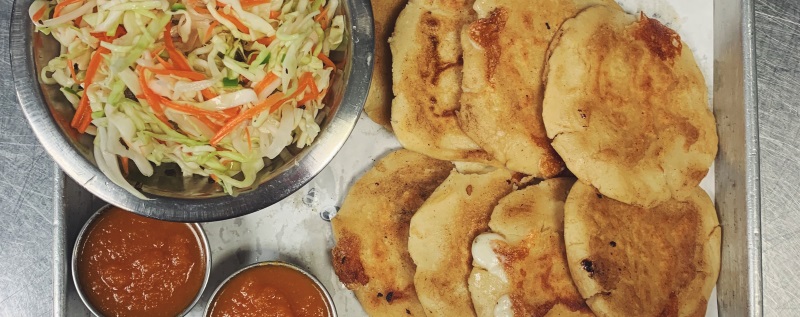
Pupusas have an ancient history. Both San Salvador and Honduras have laid claim to being the birthplace of pupusas, but San Salvador seems to be more likely. Salvadoran pupusas originated in western El Salvador among the pre-Colombian Pipil and Quiche tribes. Pupusa cooking instruments were also discovered at the site of Joya de Cerén, "El Salvador's Pompeii", which was covered in ash 2000 years ago.
The devastating Salvadoran Civil War from 1979 to 1992 brought many Salvadoran refugees to North America and they brought with them pupusas. In 2005, pupusas were declared by the Salvadoran Legislative Assembly the National Dish of San Salvador, and a National Pupusa Day is celebrated on the 2nd Sunday of November. Pupusarias can be found in many cities in the US and Canada, and in 2011 the Guardian selected pupusas as the "Best Street Food in New York City."
The exact origins of the word pupusa are not known, but common theories suggest the word is related to the meaning of "something stuffed or filled." The fillings found in Salvadoran restaurants in San Diego and beyond often reflect classic flavors and combinations. Cheese, chilies, loroco (an edible flower common in Salvadoran and Guatemalan cuisine), chicharon (fried pork) and refried beans are mainstays at any pupuseria.
According to research by David J. Guzman at the Museo Nacional de Antropologia, early pupusas were shaped into half moons and stuffed with a variety of vegetable fillings, such as squash and mushrooms. The evolution of the pupusa into its modern form was no doubt a long process, but today the stuffings consist of staples found throughout Salvadoran food.
The masa used for pupusas showcases the ingenious manipulation of corn in Mesoamerica. By a process known as nixtamalization, corn is cooked in an alkaline solution which makes it easier to grind and digest.
Corn contains niacytin, which is a form of niacin that is not digestible without nixtamalization. Niacin deficiency is one of the causes of the disease pellagra, which is found in populations that eat a lot of corn that is not prepared in this way.
Thanks to this process, Mesoamerican cultures were able to rely on corn products like masa and hominy for their baseline nutritional starch. The importance of nixtamalized corn can be seen via the ubiquitous presence of foods like tamales, tortillas, pupusas and arepas throughout North, Central and South America.
This recipe is a good base, as it can be easily personalized. You can substitute the cheese for a variety of fillings and you can use the masa to make tortillas if you so choose.
Ingredients:
For the masa*:
- 2 cups (477 grams) masa harina (ground nixtamalized corn)
- 1/2 cup (88 grams) bread flour (optional)
- 3 teaspoons kosher salt
- 1 teaspoon baking powder
- 1/4 cup lard, melted
- 2 1/2 cups warm water
*Note: I highly recommend using a scale to weigh out the flour for the masa. I like Maseca Masa Harina and King Arthur Bread flour for consistency. The masa can also be made without bread flour, in which case weigh out an additional 88 grams (1/2 cup) of masa harina for the mixture.
For the stuffing:
- 1 package Queso Oaxaca, grated (similar to Monterey Jack cheese but harder and with a string-like consistency)
For the curtido:
- 1/2 head green or white cabbage, cored and thinly sliced
- 1 carrot, peeled and shredded**
- 1/2 white onion, thinly sliced
- 2 teaspoons Mexican oregano
- 1 jalapeño or Serrano pepper, seeded and thinly sliced
- 1/4 cup apple cider vinegar
- 2 teaspoons white cane sugar
- 1 teaspoon salt
**Note: I use the Kiwi-brand Pro Slice Peeler that can be found on Amazon for about $5.00 or in South East Asian Grocery stores for a similar price.
For the salsa roja:
- 4 Roma tomatoes, chopped
- 2-4 Serrano peppers (to taste), chopped
- 1/4 white onion, chopped
- 2 garlic cloves
- 2 cups water
- 1 tablespoon neutral oil, like grapeseed
- 1 teaspoon vinegar
- 1/4 teaspoon Maggi seasoning
Preparation:
For the masa:
- Combine the masa harina, flour, salt and baking powder in a bowl and whisk to combine.
- Add the melted lard to the dry mixture and whisk again until small, pea-sized clumps form.
- Add water gradually (1/2 cup at a time) and incorporate using a wooden spoon.
- Once the dry ingredients start to form a dough, begin mixing and kneading by hand until a smooth ball forms.
- Once formed, cover the dough and allow to rest for 15 minutes before forming the pupusas.
For the salsa roja:
- Combine the first 5 ingredients in a blender and puree.
- In a saucepan, heat the oil over medium heat and add the pureed mixture and the Maggi seasoning.
- Stir the mixture carefully (it will have a tendency to spit and bubble) and cook until reduced by 1/2 (about 30-45 minutes).
- Once reduced, remove from heat and stir in the vinegar before serving.
For the curtido:
Quick version:
- Combine the cabbage, carrots, onions, jalapeño and Mexican oregano in a non-reactive bowl.
- Bring the final three ingredients to a boil in a small saucepan and stir until sugar and salt are dissolved.
- Pour the liquid into the bowl and mix by hand.
- The curtido can be eaten immediately, but I prefer to let it sit for a few hours or overnight.
Fermented version:
- Combine cabbage, carrots, onions, jalapeños, Mexican oregano and 3 tablespoons of salt in a bowl.
- Allow the mixture to sit for 30 minutes, or until cabbage has wilted slightly.
- Transfer the mixture to a clean airtight container (like a Mason jar or fermentation-grade swing top jar) and seal.
- Allow the mixture to ferment at room temperature for at least 24 hours.
- To serve, dress with 1/4 cup apple cider vinegar and 1 teaspoon of sugar or to taste. It should be tart, well salted, crunchy, slightly sweet and spicy.
For the pupusas:
- Mix 1 cup of warm water with a scant cup of oil. The oil will prevent any masa from sticking to your hands while forming.
- Separate the masa into 100 gram portions (about 3 1/2 ounces), rolling into a ball (approximately the size of a golf ball). Once separated, take a portion of dough in one hand and push the thumb of your opposite hand into the dough, making an indentation.
- Pinch around the sides of the indentation until a well for the cheese is formed.
- Stuff the well with the grated cheese and pinch the dough to seal the well (don't worry if a small amount of cheese is still visible).
- Gently pat the filled dough in your hands until even, 4-inch disks are formed.
- Repeat with the remaining dough and cheese until all the cheese is used.
- Cook the pupusas in a cast iron skillet, on a griddle, or even in a large non-stick saute pan until the middle has puffed slightly and they are brown on both sides, about 3-5 minutes per side.
- Serve with curtido and the salsa roja.
Recipe and photos by Liam Fox








